
Overview of the gastrointestinal tract.
- Subject:
- Anatomy/Physiology
- Applied Science
- Biology
- Health, Medicine and Nursing
- Life Science
- Material Type:
- Lesson
- Provider:
- Khan Academy
- Provider Set:
- Khan Academy
- Author:
- Raja Narayan
- Date Added:
- 05/15/2014

Overview of the gastrointestinal tract.
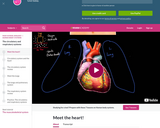
Find out exactly where the heart rests in your body and what it does. Rishi is a pediatric infectious disease physician and works at Khan Academy. Created by Rishi Desai.
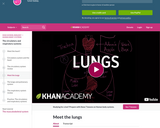
Every time you take a breath, oxygen makes it way into your lungs. Follow along on that journey! Rishi is a pediatric infectious disease physician and works at Khan Academy. Created by Rishi Desai.
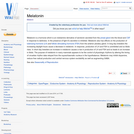
Melatonin is a hormone which is an indolamine derivative of serotonin secreted from the pineal gland into the blood and CSF in response to darkness. In the presence of light it's secretion is inhibited. Melatonin also has effects on the production of luteinizing hormone (LH) and follicle stimulating hormone (FSH) from the anterior pituitary gland. In long day breeders the increasing daylight hours cause a decrease in melatonin. In response, production of LH and FSH is uninhibited and so libido rises. In short day breeders an increase in melatonin causes a rise in production of LH and FSH and so leads to an increase in libido. The purpose of melatonin in many mammals appears to be the control of physiologic rhythms by altering the timing of circadian rhythm data relayed from the suprachiasmatic nucleus in the hypothalamus. Melatonin may inhibit dopamine, reduce free radical production and central nervous system excitability as well as augmenting GABA.
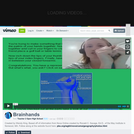
This is a 6 minute video lesson about memorizing the parts of the brain using your hands. It was created for a Psychology class and focuses on learning about where each major part of the brain is located. It's based off of the work found here: http://www.pbs.org/wgbh/nova/coma/geography/photos.html.
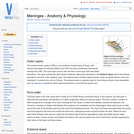
The central nervous system (CNS) is surrounded by several layers of tissue, with several outer layers not directly related to the CNS and three membranes that directly envelope the CNS. The outer layers are the skin and then a bone layer with associated periosteum. This layer includes the skull and the vertebrae. Below the periosteum is the Epidural Space which lies between periosteum and dura in the vertebral canal. The epidural space contains adipose tissue, loose connective tissue, veins and lymphatics. It cushions the cord as it flexes.
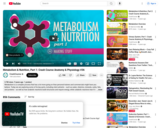
Metabolism is a complex process that has a lot more going on than personal trainers and commercials might have you believe. Today we are exploring some of its key parts, including vital nutrients -- such as water, vitamins, minerals, carbs, fats, and proteins -- as well as how anabolic reactions build structures and require energy, while catabolic reactions tear things apart and release energy.
Chapters:
Introduction: Metabolism
Metabolism, Anabolism, & Catabolism
Essential Nutrients: Water, Vitamins, Minerals
Carbohydrates
Lipids
Proteins
Review
Credits
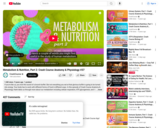
If you're like us, you love the sound of a brunch buffet. But not everything you eat at that glorious buffet is going to be turned into energy. Your body has to work with different forms of food in different ways. In this episode of Crash Course Anatomy & Physiology, Hank takes us through more about our metabolism including cellular respiration, ATP, glycogenesis, and how insulin regulates our blood sugar levels.
Chapters:
Introduction: Brunch Buffets
Cellular Respiration
Absorptive State
Basal Metabolic Rate
Insulin Regulates Blood Glucose Levels
Lipoproteins: LDL and HDL Cholesterol
Postabsorptive State
Insulin & Diabetes
Review
Credits
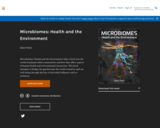
Short Description:
Microbiomes: Health and the Environment takes a look into the world of polymicrobial communities and how they affect aspects of human health and environmental interaction. This book attempts to bridge the gap between the world around us and our well-being through the lens of microbial influence and co-evolution.
Long Description:
Microbiomes: Health and the Environment was created to provide accessible insight into the novel and complex world of polymicrobial community interactions. As we push forward into the future of medicine and environmental health, it is imperative that we learn from each other, from history, and keep up to date with the latest advances in research and technology. This book not only provides content from the latest microbiome studies, but contains interactive tools, videos, and thought-provoking questions to help the reader hone and truly understand the respective topic. Though there is much overlap between themes due to the ubiquitous nature of microbes, the book is broken down into sections pertaining to both human health (e.g., gut health and disease, as well as other organ-specific niches) and aspects of the environment (e. g., nutrient cycling and climate change, marine health, soil and plant health, etc.) influenced by microbes. However, the content is designed to bridge ideas and aspects between these themes to support the One Health concept: that the health of people, animals, and the environment are all interconnected. This project will continue to grow with new findings, and adapt with the ever-changing world of microorganisms.
Word Count: 144338
Included H5P activities: 14
ISBN: 978-1-64816-002-8
(Note: This resource's metadata has been created automatically as part of a bulk import process by reformatting and/or combining the information that the author initially provided. As a result, there may be errors in formatting.)

This resource is a video abstract of a research paper created by Research Square on behalf of its authors. It provides a synopsis that's easy to understand, and can be used to introduce the topics it covers to students, researchers, and the general public. The video's transcript is also provided in full, with a portion provided below for preview:
"For people with diabetes, the dangers of high blood sugar are long established. Now, scientists have uncovered additional components in the blood that can worsen the disease. In a new article in the Journal of Physiology, researchers report that microparticles shed from cells under diabetic conditions have unique inflammatory properties that may help explain the multiple organ vascular dysfunction that’s common to the disease. Microparticles have been increasingly recognized as important biomarkers in various health conditions. But most prior reports have relied on in vitro studies to evaluate particle function. Because in vitro experiments can’t fully replicate physiological conditions, defining exactly how microparticles affect disease progression has been tricky. This prompted researchers to look at the link between microparticles and diabetes-induced vascular dysfunction in vivo, in the microvessels of streptozotocin-induced diabetic rats..."
The rest of the transcript, along with a link to the research itself, is available on the resource itself.
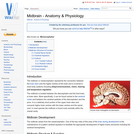
The midbrain or mesencephalon represents the connection between the brain stem and the higher centres of the brain and is involved in most body systems including sleep/consciousness, vision, hearing and temperature regulation.
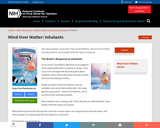
Maybe you haven't heard of inhalants, but you probably come across them pretty often. Hair spray, gasoline, spray paint -- they are all inhalants, and so are lots of other everyday products. Many inhalants have a strong smell. That's why they're called inhalants: Some people inhale the vapors on purpose. Why would anyone do this? Because the chemicals in these vapors can change the way the brain works, and those changes can make people feel very happy for a short time. But inhalants can also do harm.
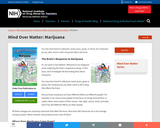
You may have heard it called pot, weed, grass, ganja or skunk, but marijuana by any other name is still a drug that affects the brain. Did you know marijuana can cause some people to lose focus on events around them? It makes others more aware of their physical sensations, and it has still more effects on other people. All these different changes are caused by chemicals that affect the brain. More than 400 chemicals are in the average marijuana plant. When smoked, heat produces even more of them!
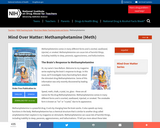
Methamphetamine is a powerful drug. It acts by changing how the brain works. It also speeds up many functions in the body. Methamphetamine has a chemical structure that is similar to another drug called amphetamine that I explore in my magazine on stimulants. Methamphetamine can cause lots of harmful things, including inability to sleep, paranoia, aggressiveness, and hallucinations.
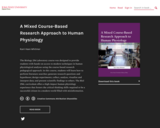
Short Description:
The Biology 256 Laboratory course was designed to provide students with hands-on access to modern techniques in human physiological analyses using the course-based research pedagogical approach. In this course, students will learn how to perform literature searches; generate research questions and hypotheses; design experiments; collect, analyze, visualize and interpret data; and present scientific findings to others. The Biol 256L curriculum offers a high-impact human physiology experience that fosters the critical thinking skills required to be a successful citizen in a modern world filled with misinformation.
Long Description:
The Biology 256 Fundamentals of Human Physiology Laboratory course was designed to provide students with hands-on access to modern techniques in human physiological analyses using the course-based research pedagogical approach. In this course, students will learn how to perform literature searches; generate research questions and hypotheses; design experiments; collect, analyze, visualize and interpret data; and present scientific findings to others. The Biol 256L curriculum offers a high-impact human physiology experience that fosters the critical thinking skills required to be a successful citizen in a modern world filled with misinformation.
Word Count: 53567
(Note: This resource's metadata has been created automatically by reformatting and/or combining the information that the author initially provided as part of a bulk import process.)

The enlarged swelling of the gastrointestinal tract between the oesophagus and the duodenum is called the stomach. It is a simple structure in carnivores and a compound structure in ruminants. The stomach functions as a reservoir of food where digestion occurs through chemical and mechanical processes. This allows food to be broken down further and absorbed.
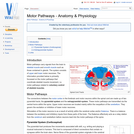
Motor pathways carry signals from the brain to skeletal muscle and smooth muscle such as those contained in glands. The system consists of upper and lower motor neurones. The information provided below is primarily focussed on the motor pathways that coordinate skeletal muscle movement, i.e. motor pathways related to voluntary control of skeletal muscles.
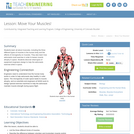
This lesson covers the topic of muscles. Students learn about the three different types of muscles in the human body and the effects of microgravity on muscles. Students also learn how astronauts need to exercise in order to lessen muscle atrophy in space. Students discover what types of equipment engineers design to help the astronauts exercise while in space.

This resource is a video abstract of a research paper created by Research Square on behalf of its authors. It provides a synopsis that's easy to understand, and can be used to introduce the topics it covers to students, researchers, and the general public. The video's transcript is also provided in full, with a portion provided below for preview:
"Scientists have uncovered new information on how sensory processing can change in multiple sclerosis, or MS. Their findings could open novel avenues for understanding and treating the disease. People with MS typically experience deficits in their ability to smell and taste, abnormal temperature processing, and heightened sensations of pain or fatigue. But there’s no clear neurocognitive mechanism to explain such diverse symptoms. A new report in the journal Human Brain Mapping suggests these changes may stem from a problem with interoception. Interoception is a lesser-known skill that helps people feel signals originating from inside of the body – such as the heart beating or the digestive system signaling hunger. Many of the sensory processing issues that characterize MS are associated with brain pathways related to interoception. This link prompted researchers to examine how these pathways are affected in the context of the disease..."
The rest of the transcript, along with a link to the research itself, is available on the resource itself.
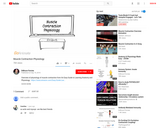
Overview of physiology of muscle contraction from An Easy Guide to Learning Anatomy and Physiology : https://www.amazon.com/Easy-Guide-Learning-Anatomy-Physi...